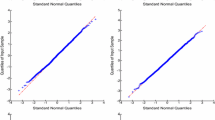Abstract
The paper deals with discrete-time regression models to analyze multistate—multiepisode models for event history data or failure time data collected in follow-up studies, retrospective studies, or longitudinal panels. The models are applicable if the events are not dated exactly but only a time interval is recorded. The models include individual specific parameters to account for unobserved heterogeneity. The explantory variables may be time-varying and random with distributions depending on the observed history of the process. Different estimation procedures are considered: Estimation of structural as well as individual specific parameters by maximization of a joint likelihood function, estimation of the structural parameters by maximization of a conditional likelihood function conditioning on a set of sufficient statistics for the individual specific parameters, and estimation of the structural parameters by maximization of a marginal likelihood function assuming that the individual specific parameters follow a distribution. The advantages and limitations of the different approaches are discussed.
Similar content being viewed by others
References
Andersen EB. (1973) Conditional inference and models for measuring. Kopenhagen.
Andersen PK, Gill RD (1982). Cox's regression model for counting processes: a large sample study. Annals of Statistics 10: 1100–1120.
Allison P (1982) Discrete-time methods for the analysis of event histories. In: Leinhardt S (ed) Sociological Methodology, pp. 61–98
Arjas E (1984). Logistic regression in modelling hazard: a fully parametric approach. Preprint, University of Oulu, Finland
Arjas E, Haara P (1986) A logistic regression model for hazards: asymptotic results. Scandinavian Journal of Statistics 13 (forthcoming)
Blossfeld HP, Hamerle A, Mayer KU (1986) Ereignisanalyse: Statistische Theorie und Anwendungen in den Wirtschafts- und Sozialwissenschaften. Campus, Frankfurt
Borgan Ø (1984) Maximum likelihood estimation in parametric counting process models, with applications to censored failure time data. Scaninavian Journal of Statistics 11: 1–16, Correction 11: 275
Breslow NE (1974). Covariance analysis of censored survival data. Biometrics 30: 89–99
Chamberlain G (1980). Analysis of covariance with qualitative data. Review of Economic Studies 17: 225–238.
Chamberlain G (1984). Panel data Handbook of Econometrics, Vol. II (Z. Griliches & M Intriligator, Eds.), North-Holland, Amsterdam
Chamberlain G (1985) Heterogeneity, omitted variable bias, and duration dependence. In: Heckman J, Singer B (eds) Longitudinal analysis of labor market data. Cambridge University Press, Cambridge
Cox DR (1975) Partial likelihood, Biometrika 62: 269–276
Cox DR, Oakes D (1984) Analysis of survival data. Chapman and Hall, London
Haberman SJ (1977) Maximum likelihood estimates in exponential response models. Annals of Statistics 5: 815–841
Hamerle A (1984) Zur statistischen Analyse von Zeitverläufe. Diskussionsbeitrag Nr 180, Universität Regensburg
Hamerle A (1985) Regressionsmodelle für gruppierte Verweildauern und Lebenszeiten. Zeitschrift Operations Research 29, B: 243–260
Hanefeld U (1984) Das Sozio-ökonomische Panel—eine Längsschnittstudie für die Bundesrepublik Deutschland. Viereteljahreshefte zur Wirtschaftsforschung 4/84:391–406.
Hausman J, McFadden D (1984) Specification tests for the multinomial logit model. Econometrica 52: 1219–1240
Heckman J (1981a) Statistical models for discrete panel data. In: Manski CF, McFadden D (eds) Structural analysis of discrete data with econometric applications, MIT Press, Cambridge, Mass.: 114–178.
Heckman J (1981b) The incidental parameter problem and the problem of initial conditions in estimating a discrete time-discrete data stochastic process. In: Manski CF, McFadden D (eds) Structural analysis of discrete data with econometric applications. MIT Press, Cambridge, Mass.: 179–195
Heckman J, Singer B (1984). Econometric duration analysis. Journal of Econometrics 24: 63–132
Hujer R, Schneider H (1986) Ökonometrische Ansätze zur Analyse von Paneldaten: Schätzung und Vergleich von Übergangsratenmodellen. Manuskript, Frankfurt.
Kalbfleich JD, Prentice RL (1980) The statistical analysis of failure time data. Wiley, New York
Laird N, Olivier D (1981) Covarance analysis of censored survival data using log-linear analysis techniques. Journal of the American Statistical Association 76: 231–240
Lawless JF (1982) Statistical models and methods for lifetime data. Wiley New York
Liang KY, Zeger SL (1986) Longitudinal data analysis using generalized linear models. Biometrika 73: 13–22
Mantel N, Hankey BF (1978) A logistic regression analysis of response-time data where the hazard function is time dependent. Communications in Statistics A7: 333–347
McCullagh P (1983) Quasi-likelihood functions. Annals of Statistics 11: 59–67
Neyman J, Scott EL (1948) Consistent estimates based on partially consistent observations. Econometrica 16: 1–32
Prentice RL, Gloeckler LA (1978). Regression analysis of grouped survival data with applications to breast cancer data. Biometrics 34: 57–67
Stiratelli R, Laird N, Ware J (1984). Random effect models for serial observations with binary responses. Biometrics 40: 961–971
Thompson WA Jr (1977) On the treatment of grouped observations in life studies. Biometrics 33: 463–470
Tuma NB, Hannan MT (1984) Social dynamics: Models and methods. Academic Press, New York.
Author information
Authors and Affiliations
Rights and permissions
About this article
Cite this article
Hamerle, A. Regression analysis for discrete event history or failure time data. Statistische Hefte 27, 207–225 (1986). https://doi.org/10.1007/BF02932568
Received:
Revised:
Issue Date:
DOI: https://doi.org/10.1007/BF02932568



